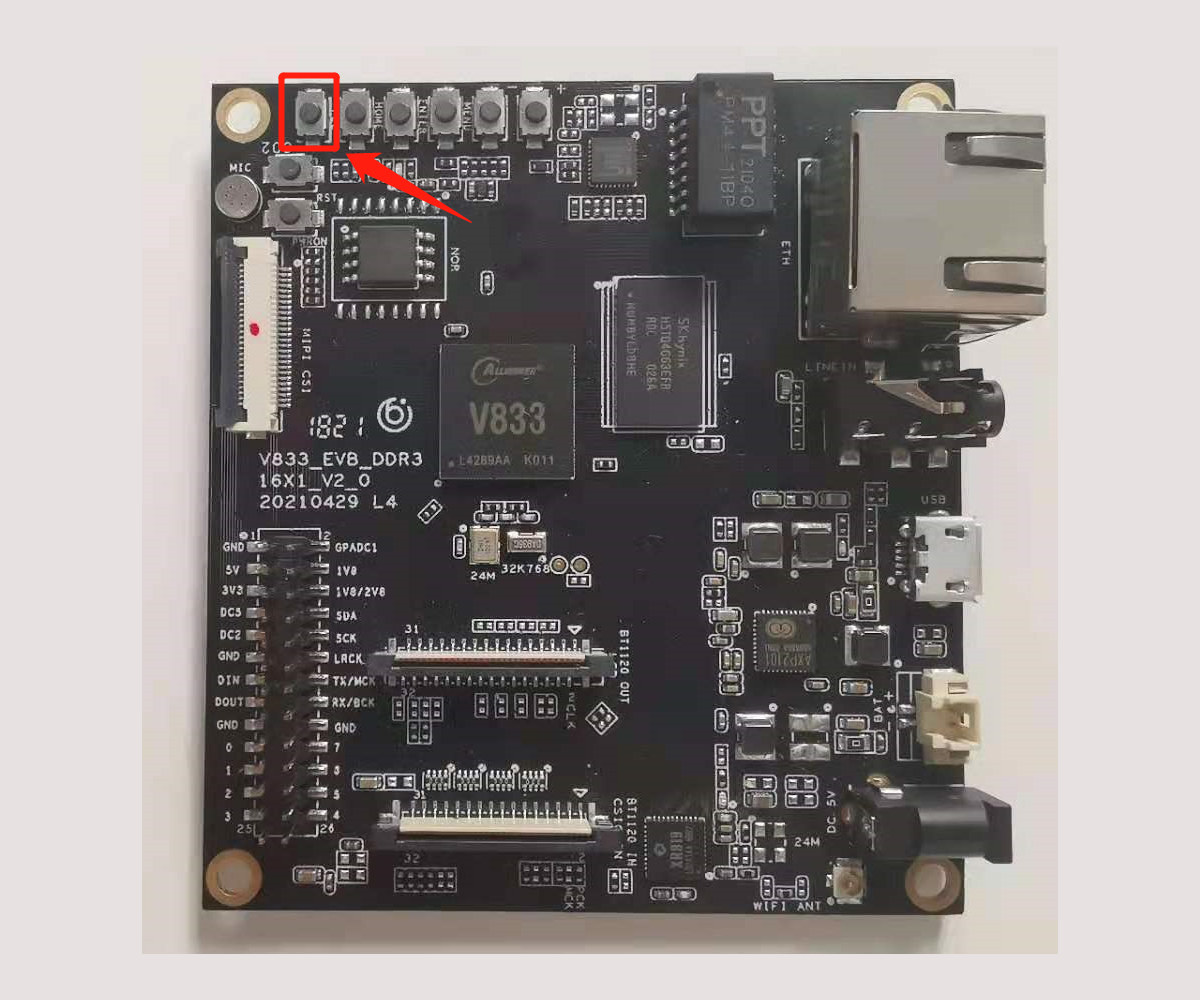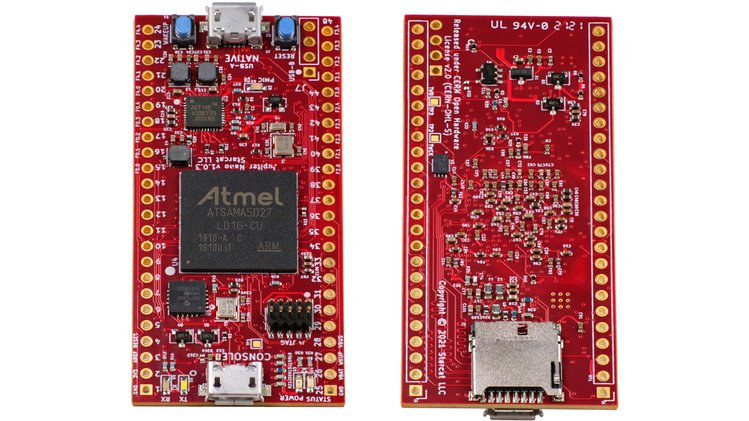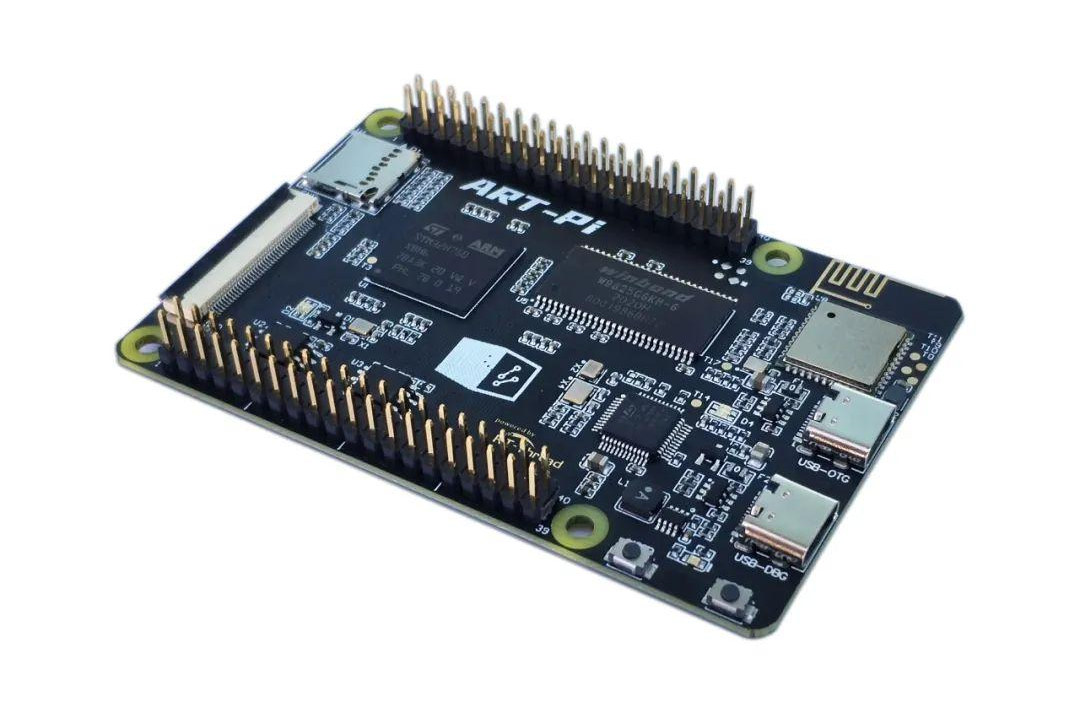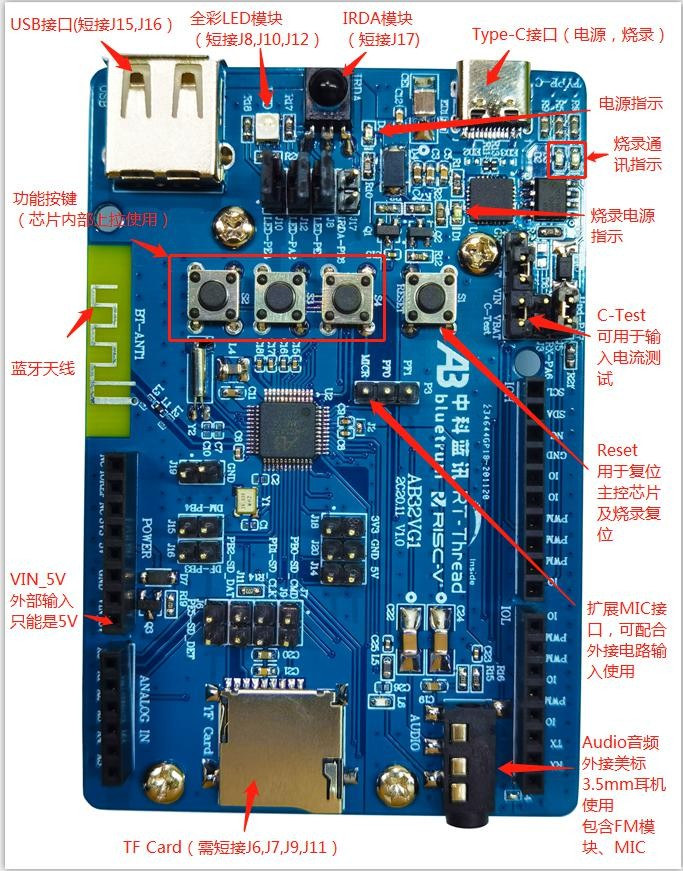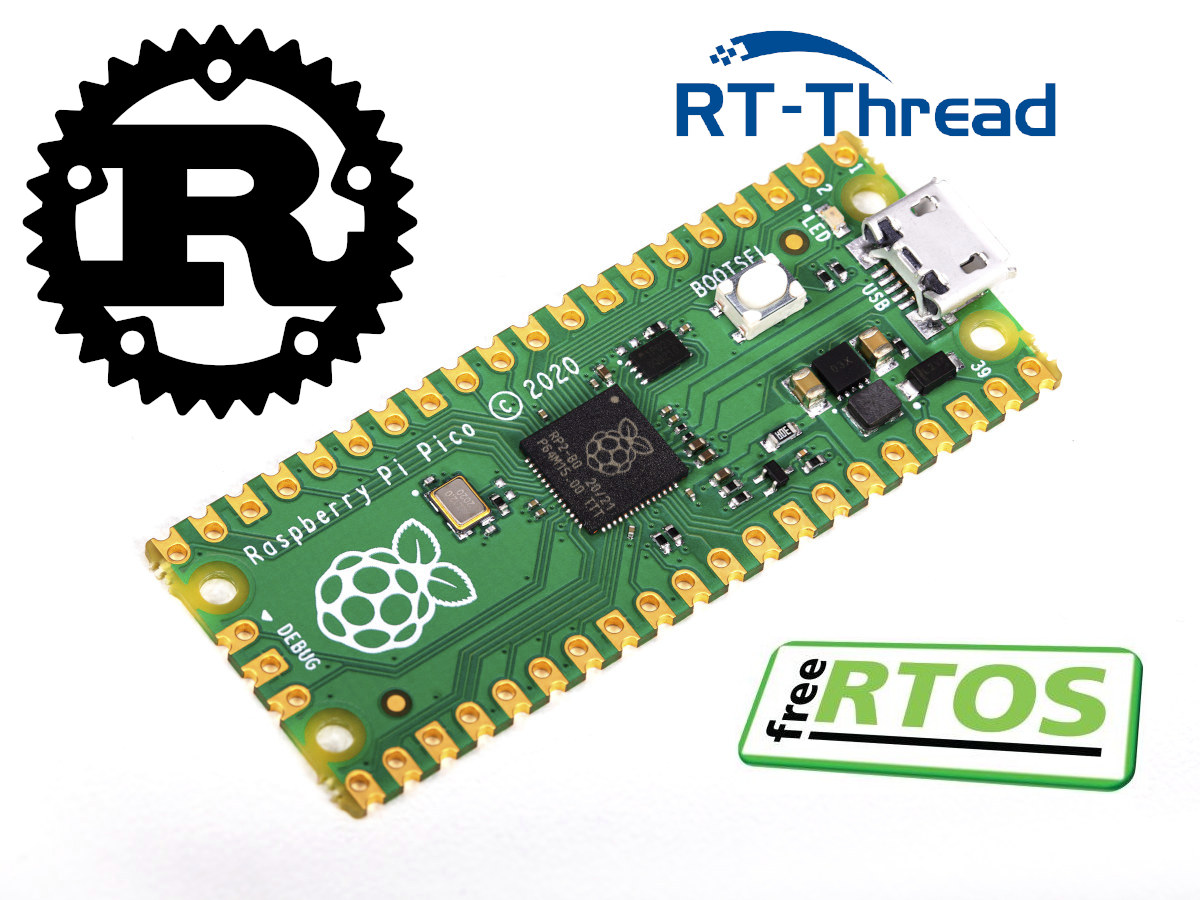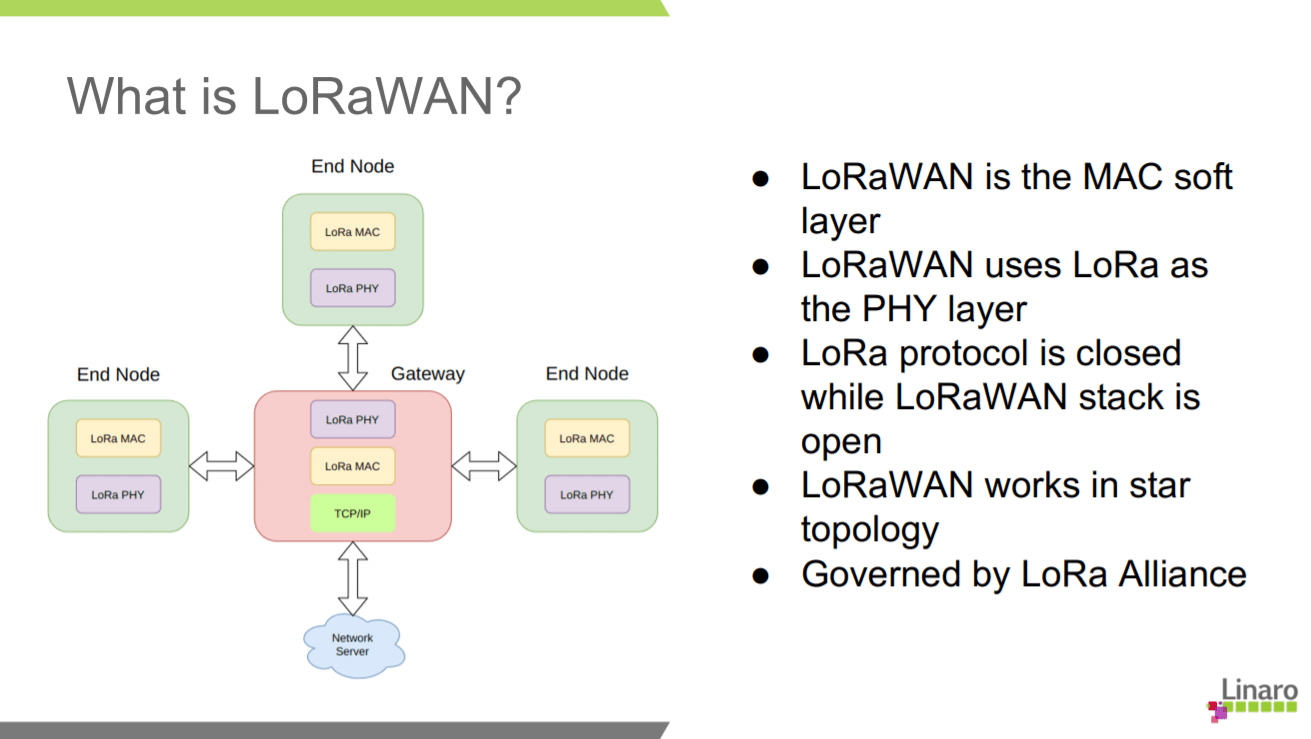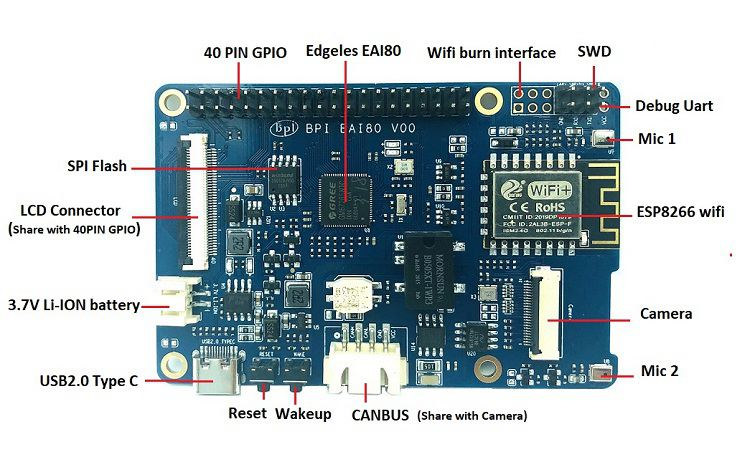Lindenis V833 is an AI video/camera development board based on Allwinner V833 single-core Cortex-A7 processor with a 400 MOPS AI accelerator (NPU) and running OpenWrt-based Tina Linux or Melis RTOS based on the RT-Thread kernel. The board comes with up to 3GB RAM, a MicroSD card socket, MIPI DSI, MIPI CSI, and BT1120 interfaces for video output and input, Gigabit Ethernet, 2.4 GHz WiFi, and a few other I/Os. Lindenis V833 specifications: SoC – Allwinner V833 single-core Arm Cortex-A7 processor @ up to 1.2 GHz with H.265/H.265 1080p video encoder, MJPEG 1080p video encoder, 400 MOPS AI accelerator (See PDF datasheet) System Memory – Up to 3GB DDR3/DDR3L Storage – MicroSD card slot with support for SDHC and SDXC, SPI NOR flash Display Interfaces 4-lane MIPI-DSI up to 1080p BT1120 output Touch panel header Video In 4-lane MIPI-CSI camera interface BT1120 input Audio – 3.5mm Line-in jack, built-in microphone Connectivity […]
Jupiter Nano – Tiny Cortex-A5 board runs Linux or NuttX RTOS (Crowdfunding)
Jupiter Nano looks like one of those small MCU boards, but instead of a microcontroller, it packs a 500 MHz Microchip SAMA5 Cortex-A5 processor with 128MB RAM capable of running Linux or NuttX operating systems. The board reminds me of the Adafruit Feather compatible Giant Board made by Groboards, with the same system-in-package, but Juniper Nano offers more I/Os via 48 through holes, and its size is said to be similar to Teensy 4.1 board (but not quite). Jupiter Nano specifications: SiP – Microchip SAMA5D27C-LD1G with Cortex-A5 processor running at 498 MHz, 128MB LPDDR2 DRAM Storage – MicroSD card socket (bootable) USB – 1x Micro USB 2.0 host/device port, 1x USB 2.0 host on header Expansion – 2x 24-pin headers with GPIOs, USB, SPI, I2C, up to 4x Flexcom interfaces configurable as SPI, UART or I2C Programming – JTAG port, Micro USB 2.0 FS debug console via MCP2200 USB-UART converter […]
Upcoming events about RISC-V, RT-Thread IoT OS, and Embedded Linux
Three events about open/open-source technologies have been recently announced with namely the RT-Thread IoT OS Tech Conference, the jointly organized Open Source Summit and Embedded Linux Conference 2021, and the 2021 RISC-V Summit. Let’s have a quick look at what each will have to offer with the list in chronological order. RT-Thread IoT OS Global Tech Conference 2021 The first-ever RT-Thread IoT OS Global Tech Conference will take place online on September 16–17,2021, be free to attend, and feature talks about embedded technologies, new projects showcase, community contributors track mostly related to RT-Thread open-source real-time operating system, but also IoT development in general. The agenda has not been published just yet, as the call for speakers is still open until August 8th. People just wanting to attend can register through a Google Docs form. Somehow there’s no landing page on the main page, and instead, they’ve decided to publish information […]
Art-Pi STM32H750 Cortex-M7 board supports RT-Thread, mainline Linux
I like to browse Linux changelog to learning about new features in the kernel, but also new hardware that made it into mainline Linux, even if only preliminary or partial. And in the just-released Linux 5.13, one board that caught my eye was Art-Pi, powered by an STMicro STM32H750 Cortex-M7 microcontroller without MMU (memory management unit) that was initially designed for RT-Thread real-time operating system. Art-Pi specifications: MCU – STM32H750XBH6 Value Line Cortex-M7 microcontroller @ 400 MHz, with 128KB flash, 16KB D/I cache, 864 SRAM, 64KB+128KB TCM with ECC correction System Memory – 32MB SDRAM Storage – MicroSD card slot, 16 MB SPI flash, 8MB QSPI flash Display – FPC connector for RGB888 displays Connectivity – SDIO WiFi 4 and UART Bluetooth via Ampak AP6212 module USB – 1x USB OTG Type-C port Debugging – On-board ST-LINK/V2.1 via USB-C DBG port Expansion – 2x 40-pin P1 & P2 headers with […]
Bluetrum AB32VG1 board features AB5301A Bluetooth RISC-V MCU, runs RT-Thread RTOS
Bluetrum, a Shenzhen-based fabless company focusing on audio chips, has designed the AB32VG1 board based on its AB5301A Bluetooth RISC-V MCU for general-purpose and audio applications. The board comes with a MicroSD card, a USB port, a 3.5mm audio jack, and Arduino UNO compatible headers for easy prototyping. Bluetrum AB32VG1 board preliminary specifications: MCU – Bluetrum AB5301A RISC-V MCU @ 120 MHz (overclockable to 192 MHz) with 192KB RAM, 1MB flash, Bluetooth 5.0 connectivity and FM radio; LQFP48 package Storage – MicroSD card slot Audio – 3.5mm audio jack, 3-pin microphone header Connectivity – Bluetooth 5.0 with PCB antenna USB – USB 2.0 host port, USB Type-C port for power and programming Expansion – Arduino UNO header with 1x I2C, 6x ADC, 6x PWM Misc – IR receiver, 3x user buttons, 1x reset button, RGB LED, power LED, status LEDs, various configuration jumper Power Supply – 5V via USB Type-C […]
Raspberry Pi Pico Gets supports for Rust, RT-Thread OS and FreeRTOS
In January end, we saw the launch of Raspberry Pi Pico equipped with an RP2040 dual-core Cortex-M0+ microcontroller working up to 133 MHz with official support for MicroPython and C. In this feature, we will be discussing the Raspberry Pi Pico’s flexible software support compatible with RP2040 MCU, apart from the MicroPython, C/C++, and upcoming Arduino IDE software support. We will specifically be focusing on Rust, RT-Thread OS, and FreeRTOS support for Raspberry Pi Pico. Rust Code Running on Raspberry Pi Pico Rust language is considered fast, reliable, and secure when it comes to IoT gateways. It also opens up the option for writing extremely low-level code, such as operating system kernels or microcontroller applications. Porting Rust with RP2040 for working with Raspberry Pi Pico was seen in Jonathan Pallant’s Twitter Feed. The RP2040 comes with an external QSPI flash. The internal mask-ROM reads the programs from the external flash […]
LoRa & LoRaWAN support in Zephyr OS
The story of LoRa began in 2009 when Cycleo, a French company, invented LoRa. LoRa (Long Range) support for Zephyr OS goes back to December 2019. Since then, there has been a huge interest among the community to extend their support for it. More recently, LoRaWAN (low-power wide-area network) support was added to Zephyr OS. This will provide true networking support to Zephyr OS over LoRa. It operates in licensed free Sub Gigahertz frequencies (865 MHz-India, 868 MHz-Europe, etc…). It makes the perfect choice for low data rates and long-range applications. What is LoRaWAN? LoRaWAN is a MAC layer that sits on top of the LoRa. According to the OSI model, LoRaWAN is the MAC (media access control) layer while LoRa is the PHY (physical) layer. LoRa protocol is closed, meaning it is proprietary to Semtech, while LoRaWAN specifications are open to the public. The reference implementation is available at […]
$16 Banana Pi BPI-EAI80 Cortex-M4F Board Embeds AI Accelerator, WiFi Module
Last April, we wrote about Edgeless EAI-Series dual Arm Cortex-M4 MCU equipped with a 300 GOPS CNN-NPU for AI at the very edge as we had discovered the chip in an upcoming Banana Pi board. It turns out Banana Pi BPI-EAI80 development board powered by Edgeless EAI80 AI microcontroller has just launched for $16 on Aliexpress, or you could get a complete kit with a touchscreen display, a camera, and a USB power supply for $80. Banana Pi BPI-EAI80 development board specifications: System-in-Package – Edgeless EIA80 dual-core Cortex-M4F microcontroller @ 200MHz with 300GOPS AI accelerator (CNN-NPU), 384KB of SRAM including 256KB for CNN-NPU, and 8MB SDRAM Storage – SPI flash Display I/F – LCD connector up to 1024×768 Camera I/F – 1x DVP camera interface Audio – 2x onboard microphones Connectivity – 2.4GHz 802.11b/g/n WiFI 4 using ESP8266 module USB – 1x USB 2.0 Type-C port Expansion 40-pin GPIO header […]


